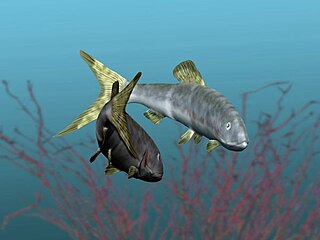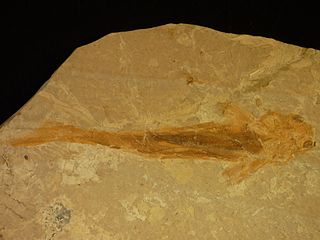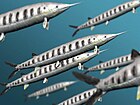
Actinistia is a subclass of mostly fossil lobe-finned fishes. This subclass contains the coelacanths, including the two living species of coelacanths, both of the genus Latimeria: the West Indian Ocean coelacanth and the Indonesian coelacanth.
Pholidophorus is an extinct genus of stem-teleost fish. Numerous species were assigned to this genus in the past, but only the type species Pholidophorus latiusculus, from the Late Triassic of Europe, is considered to be a valid member of the genus today.
Neopholidophoropsis is an extinct genus of stem-teleost ray-finned fish that lived in what is now Germany during the Aptian stage of the Early Cretaceous epoch. It contains one species, Neopholidophoropsis serrata.
Bobbichthys is an extinct genus of ray-finned fish that lived in what is now Chile during the Oxfordian stage of the Late Jurassic epoch.
Atacamichthys is an extinct genus of ray-finned fish. It contains one species, Atacamichthys greeni, which lived in what is now Chile during the Oxfordian stage of the Late Jurassic epoch. Atacamichthys is the only member of the family Atacamichthyidae.
Oligopleurus is an extinct genus of prehistoric bony fish that lived during the Kimmeridgian stage of the Late Jurassic epoch.
Luisiella is an extinct genus of prehistoric bony fish that lived during the Kimmeridgian stage of the Late Jurassic epoch. Fossils of the genus have been found in either the Cañadón Calcáreo Formation or Cañadón Asfalto Formation in Chubut Province, Argentina.

Euthynotus is an extinct genus of prehistoric bony fish that lived during the early Toarcian stage of the Early Jurassic epoch. It is generally considered the basalmost pachycormiform.
Parapleuropholis is an extinct genus of ray-finned fish that lived in what is now the Democratic Republic of the Congo during the early Toarcian stage of the Early Jurassic epoch.

Luisichthys is an extinct genus of ray-finned fish that lived in what is now Cuba from the Oxfordian to the early Tithonian stage of the Late Jurassic epoch. It contains one species, Luisichthys vinalesensis.

Asthenocormus is an extinct genus of pachycormiform ray-finned fish. A member of the edentulous suspension feeding clade within the Pachycormiformes, fossils have been found in the Upper Jurassic plattenkalks of Bavaria, Germany.

Eurycormus is an extinct genus of prehistoric bony fish that lived from the Callovian stage of the Middle Jurassic epoch to the early Tithonian stage of the Late Jurassic epoch.
Swenzia is an extinct genus of coelacanthid fish from the late Jurassic of France. It contains a single species, S. latimerae, which was originally described as Wenzia latimerae. Because the generic name Wenzia was already preoccupied by a snail, the generic name was amended to Swenzia. It is the fossil genus most closely related to the living coelacanth, Latimeria.
Ankylophorus is an extinct genus of stem-teleost ray-finned fish that lived in what is now France during the Late Jurassic. Its type and only species, Ankylophorus similis, was originally named in 1895 as a species of Pholidophorus, but was moved to a separate genus in 1978.

Orthocormus is an extinct genus of prehistoric pachycormiform bony fish. It is known from three species found in Kimmeridgian aged plattenkalk deposits in Bavaria, Germany. The species "Hypsocormus" tenuirostris Woodward 1889 from the late Middle Jurassic (Callovian) Oxford Clay is not closely related to the type species of Hypsocormus, and is more closely related to Orthocormus + Protosphyraena, and thus has sometimes been referred to in open nomenclature as Orthocormus? tenuirostris.

Saurorhynchus is an extinct genus of carnivorous bony fish. It is the youngest representative of the family Saurichthyidae and the order Saurichthyiformes. This family is known for its large, elongate jaws, similar to modern Belonidae. Saurichthyidae also includes the Permian genus Eosaurichthys and the Triassic genus Saurichthys.

Peipiaosteus is an extinct genus of prehistoric chondrostean ray-finned fish. Its fossils are found in the Early Cretaceous Jiufotang Formation, Pani Lake, Liaoning Province, China.

Ohmdenia is an extinct genus of prehistoric bony fish that lived from the Toarcian stage of the Early Jurassic epoch. Ohmdenia was first described in 1953 by B. Hauff, based on a fossil found in the well-known Posidonia Shale in Holzmaden, Germany. For a long time this animal has been considered a close relative of Birgeria, a great predator typical of the Triassic period with an uncertain systematic position. Further studies have shown similarities with the Pachycormiformes, a group considered close to the origin of teleosts and also including giant forms and planktives. Some studies have erroneously indicated Ohmdenia as a synonym of Saurostomus, other studies have instead placed Ohmdenia as an important evolutionary passage between the basal pachicormiforms and the more derived planktivore pachicormiformes.

Orthogonikleithrus is a genus of extinct ray-finned fish that lived during the Late Jurassic period. It lived in lagoonal and restricted shallow subtidal zones.

Ginglymodi is a clade of ray-finned fish containing modern-day gars (Lepisosteidae) and their extinct relatives, including the family Lepidotidae and the orders Semionotiformes and Kyphosichthyiformes, and various other extinct taxa. Ginglymodi is one of the two major subgroups of the infraclass Holostei, the other one being Halecomorphi, which contains the bowfin and its fossil relatives.

















